technical specifications Seat Alhambra 2013 User Guide
[x] Cancel search | Manufacturer: SEAT, Model Year: 2013, Model line: Alhambra, Model: Seat Alhambra 2013Pages: 387, PDF Size: 6.13 MB
Page 25 of 387

23
Seat belts
Fastening the seat belt
Fasten your seat belt before each trip.
● Adjust the front seat and head restraint correctly ⇒ page 10.
● Engage the seat backrest of the rear seat in an upright position ⇒
.
● Pull the latch plate and place the belt webbing evenly across your chest
and lap. Do not twist the seat belt when doing so ⇒
.
● Engage the latch plate in the buckle of the corresponding seat ⇒ Fig. 10.
● Pull the belt to ensure that the latch plate is securely engaged in the
buckle.
Unfastening the seat belt
The seat belt must not be unfastened until the vehicle has come to a stand-
still ⇒
.
● Press the red button on the buckle ⇒ Fig. 11. The latch plate is released
from the buckle.
● Guide the belt back by hand so that it rolls up easily and the trim will not
be damaged.
WARNING
An incorrectly worn seat belt web can cause severe or fatal injuries in the
event of an accident.
● The seat belt cannot offer its full protection unless the seat backrests
are in an upright position and the seat belt is worn correctly, according to
your size.
● Unbuckling your seat belt while the vehicle is in motion can cause se-
vere or fatal injuries in the event of an accident or sudden braking.
Fastening or unfastening the seat belt with two buckles
Fig. 12 Fasten the seat
belt on the centre seat in
the second row of seats
Properly worn seat belts hold the vehicle occupants in the position that
most protects them in the event of an accident or sudden braking ⇒
.
The seat belts for the centre seat in the second row of seats and for the
seats in the third row of seats are fastened using two buckles.
Fastening the seat belt
Fasten your seat belt before each trip.
● Adjust the rear seat and head restraint correctly
⇒ page 10.
● Engage the seat backrest of the rear seat in an upright position
⇒
.
● Use latch plate of the belt
⇒ Fig. 12 1 to pull the seat belt down. Do
not
twist the seat belt when doing so ⇒ .
● Engage the latch plate 1 in the buckle of the corresponding seat A.
● Use the latch plate 2 to pull the seat belt across your lap.
● Engage the latch plate 2 in the buckle of the corresponding seat B.
● Pull the belt to ensure that both latch plates are securely engaged in the
buckles.
Safety FirstOperating instructionsPractical tipsTechnical Specifications
Page 27 of 387
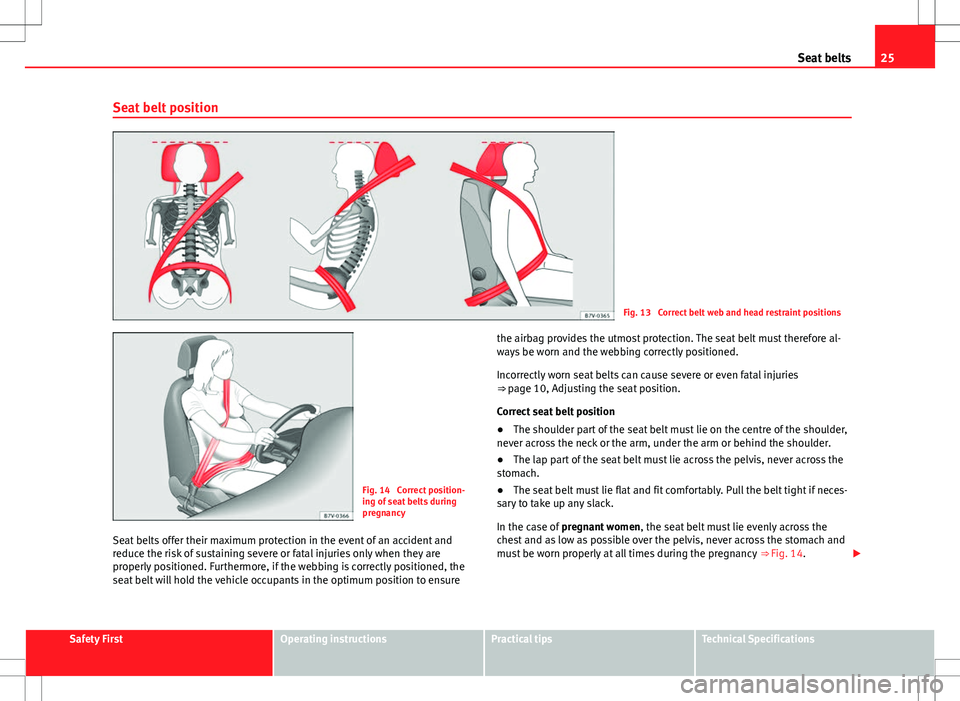
25
Seat belts
Seat belt position
Fig. 13 Correct belt web and head restraint positions
Fig. 14 Correct position-
ing of seat belts during
pregnancy
Seat belts offer their maximum protection in the event of an accident and
reduce the risk of sustaining severe or fatal injuries only when they are
properly positioned. Furthermore, if the webbing is correctly positioned, the
seat belt will hold the vehicle occupants in the optimum position to ensure the airbag provides the utmost protection. The seat belt must therefore al-
ways be worn and the webbing correctly positioned.
Incorrectly worn seat belts can cause severe or even fatal injuries
⇒ page 10, Adjusting the seat position.
Correct seat belt position
●
The shoulder part of the seat belt must lie on the centre of the shoulder,
never across the neck or the arm, under the arm or behind the shoulder.
● The lap part of the seat belt must lie across the pelvis, never across the
stomach.
● The seat belt must lie flat and fit comfortably. Pull the belt tight if neces-
sary to take up any slack.
In the case of pregnant women , the seat belt must lie evenly across the
chest and as low as possible over the pelvis, never across the stomach and
must be worn properly at all times during the pregnancy ⇒ Fig. 14.
Safety FirstOperating instructionsPractical tipsTechnical Specifications
Page 29 of 387

27
Seat belts
WARNING
Never adjust the belt height while the vehicle is in motion.
Seat belt tensioners
Automatic belt retainer, belt tensioner, belt tension limiter
Seat belts are part of the vehicle safety concept ⇒ page 32 and consist of
the following important functions:
Automatic belt retainer
Every seat belt is equipped with an automatic belt retainer on the shoulder
belt. If the belt is pulled slowly or during normal driving, the system allows
for total freedom of movement on the shoulder belt. However, during sud-
den braking, during travel in mountains or bends and during acceleration,
the automatic belt retainer on the seat belt is locked is pulled quickly.
Belt tensioners
The seat belts on the front seats and the outer seats of the second row are
equipped with belt tensioners.
Sensors will trigger the belt tensioners during severe head-on, lateral and
rear collisions and retract and tighten the seat belts. If the seat belt is
loose, it is retracted to reduce the forwards movement of vehicle occupants
or movement in the direction of the collision. The belt tensioner works in
combination with the airbag system. The belt tensioner will not be triggered
in the event of the vehicle overturning if the side airbags are not deployed.
If the belt tensioner is triggered, a fine dust is produced. This is normal and
it is not an indication of fire in the vehicle. Belt tension limiter
The belt tension limiter reduces the force of the seat belt on the body in the
event of an accident.
Note
The relevant safety requirements must be observed when the vehicle or
components of the system are scrapped. These requirements are known to
specialised workshops ⇒ page 27.
Service and disposal of belt tensioners
If you work on the belt tensioners or remove and install other parts of the
vehicle when performing other repair work, the seat belt may be damaged.
The consequence may be that, in the event of an accident, the belt tension-
ers function incorrectly or not at all.
So that the effectiveness of the belt tensioner is not reduced and that re-
moved parts do not cause any injuries or environmental pollution, regula-
tions must be observed. These requirements are known to specialised work-
shops.
WARNING
Improper handling and homemade repairs of seat belts, automatic belt
retainers and tension devices increase the risk of sustaining severe or fa-
tal injuries. The belt tensioner may fail to trigger or may trigger in the
wrong circumstances.
● Never attempt to repair, adjust or remove or install parts of the belt
tensioners or seat belts. Any work must be performed by a specialised
workshop only ⇒ page 260.
● Belt tensioners and automatic belt retainers cannot be repaired and
must be replaced.
Safety FirstOperating instructionsPractical tipsTechnical Specifications
Page 31 of 387

29
Airbag system
Airbag system
Brief introduction Introduction
Front airbags have been installed for both driver and passenger. The front
airbags can also protect the chest and head of driver and passenger if the
seats, seat belts head restraints and, for the driver, the steering wheel are
correctly adjusted and used. Airbags are considered as additional safety
equipment. An airbag cannot replace the seat belt, which must be worn at
all times, even in front seats where front airbags have been installed.
Additional information and warnings:
● Driving tips ⇒ page 7
● Correct sitting positions ⇒ page 10
● Seat belts ⇒ page 21
● Child seats (accessories) ⇒ page 40
● Care and cleaning of the vehicle interior ⇒ page 252
● Accessories, parts replacement, repairs and modifications ⇒ page 260
● Notes for the user ⇒ page 258
WARNING
Never exclusively trust the airbag system as a means of protection.
● Even when triggered, airbag protection is only auxiliary.
WARNING (Continued)
● The airbags provide the best protection when the seat belts are prop-
erly fastened, thus reducing the risk of sustaining injuries ⇒ page 21,
Seat belts.
● Before each trip, every occupant must sit properly, correctly fasten
the seat belt belonging to his or her seat and keeping it fastened
throughout the trip. This rule is valid for all vehicle occupants.
WARNING
Vehicle occupants sitting in the front of the vehicle must never carry any
objects in the deployment space between them and the airbags, as this
increases the risk of sustaining injuries if the airbag is triggered. This
modifies the airbag deployment space or the objects may fly uncontrolla-
bly and hit your body.
● Never carry objects in your hand or on your lap while the vehicle is in
motion.
● Never transport objects on the front passenger seat. In the event of
sudden braking and manoeuvres, the objects may end up in the airbag
deployment space and fly uncontrollably around the vehicle interior if the
airbag is activated.
● Vehicle occupants of the front and outer rear seats must never carry
any other people, pets or objects in the deployment space between them
and the airbags. Make sure children and other passengers also respect
this recommendation.
Safety FirstOperating instructionsPractical tipsTechnical Specifications
Page 33 of 387
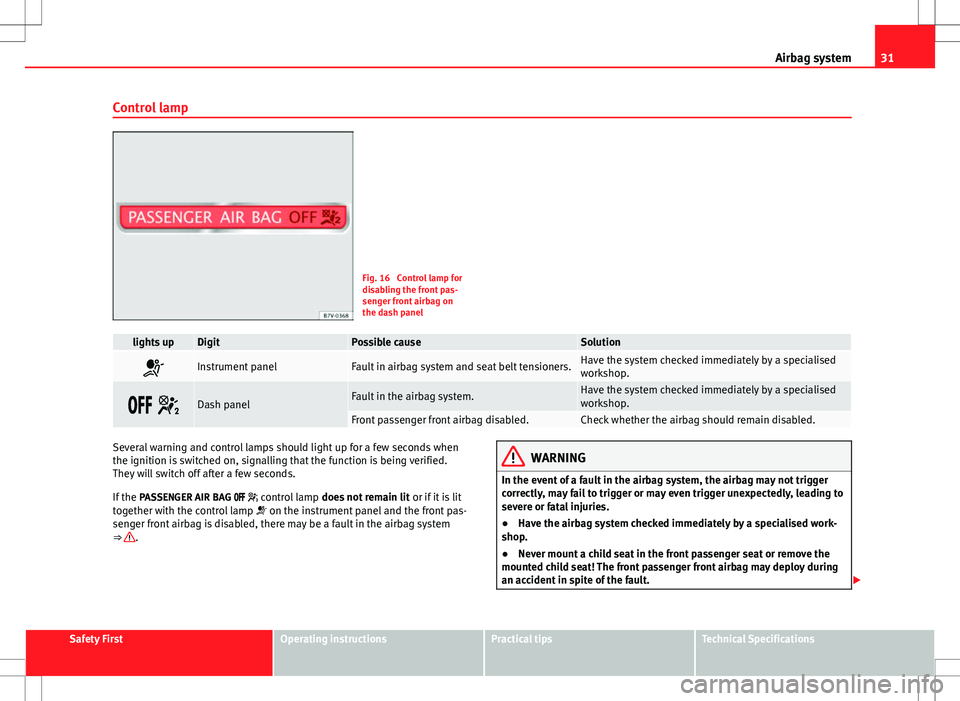
31
Airbag system
Control lamp
Fig. 16 Control lamp for
disabling the front pas-
senger front airbag on
the dash panel
lights upDigitPossible causeSolution
Instrument panelFault in airbag system and seat belt tensioners.Have the system checked immediately by a specialised
workshop.
Dash panelFault in the airbag system.Have the system checked immediately by a specialised
workshop.
Front passenger front airbag disabled.Check whether the airbag should remain disabled.
Several warning and control lamps should light up for a few seconds when
the ignition is switched on, signalling that the function is being verified.
They will switch off after a few seconds.
If the PASSENGER AIR BAG control lamp does not remain lit or if it is lit
together with the control lamp on the instrument panel and the front pas-
senger front airbag is disabled, there may be a fault in the airbag system
⇒
.
WARNING
In the event of a fault in the airbag system, the airbag may not trigger
correctly, may fail to trigger or may even trigger unexpectedly, leading to
severe or fatal injuries.
● Have the airbag system checked immediately by a specialised work-
shop.
● Never mount a child seat in the front passenger seat or remove the
mounted child seat! The front passenger front airbag may deploy during
an accident in spite of the fault.
Safety FirstOperating instructionsPractical tipsTechnical Specifications
Page 35 of 387
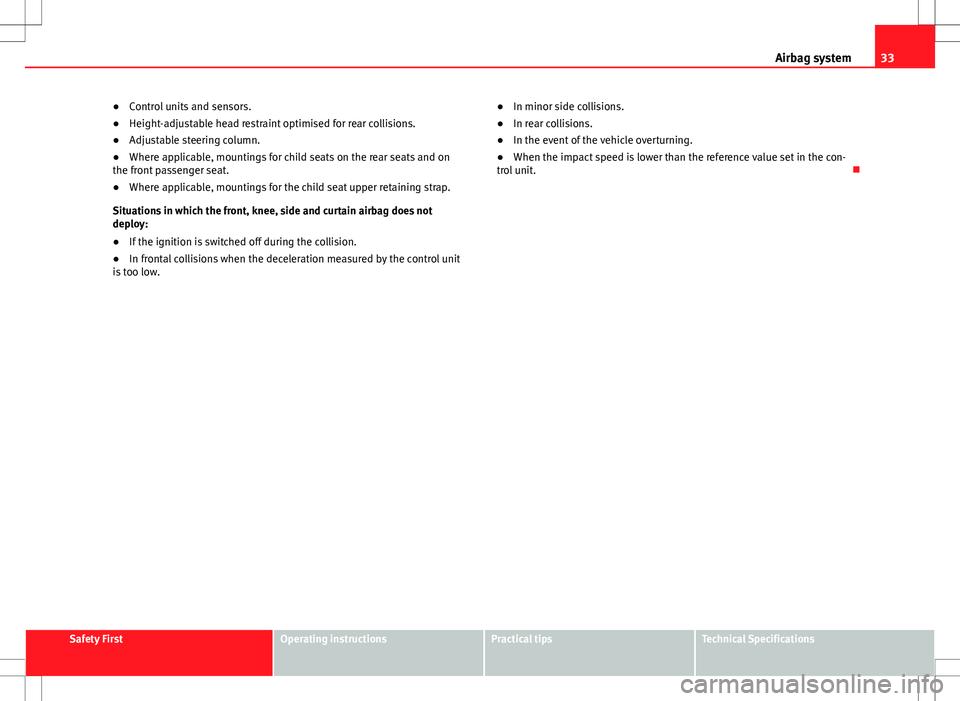
33
Airbag system
● Control units and sensors.
● Height-adjustable head restraint optimised for rear collisions.
● Adjustable steering column.
● Where applicable, mountings for child seats on the rear seats and on
the front passenger seat.
● Where applicable, mountings for the child seat upper retaining strap.
Situations in which the front, knee, side and curtain airbag does not
deploy:
● If the ignition is switched off during the collision.
● In frontal collisions when the deceleration measured by the control unit
is too low. ●
In minor side collisions.
● In rear collisions.
● In the event of the vehicle overturning.
● When the impact speed is lower than the reference value set in the con-
trol unit.
Safety FirstOperating instructionsPractical tipsTechnical Specifications
Page 37 of 387
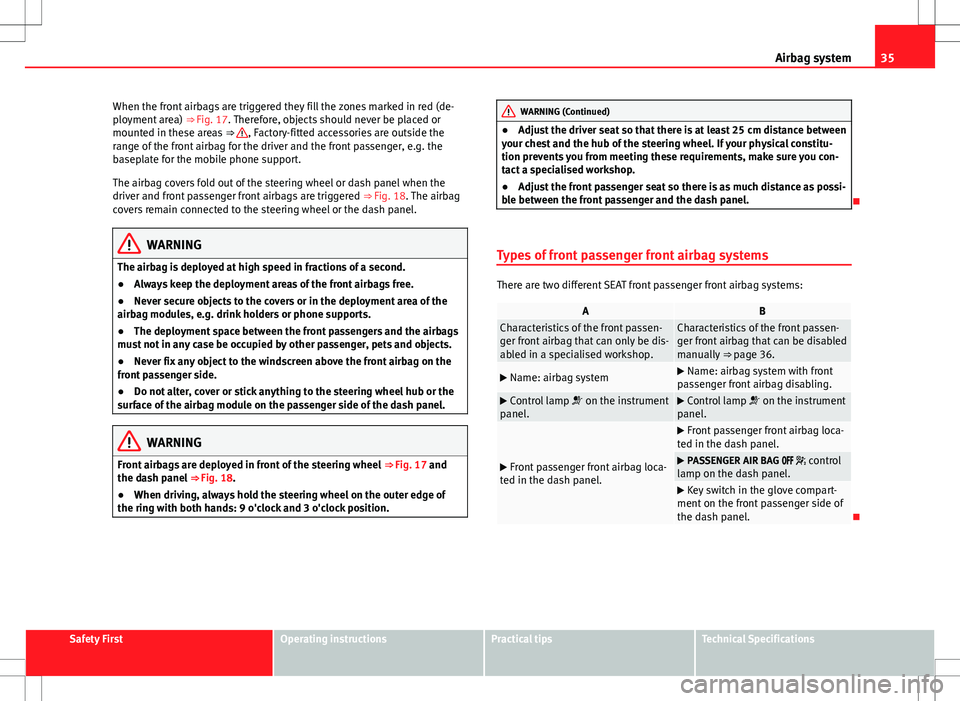
35
Airbag system
When the front airbags are triggered they fill the zones marked in red (de-
ployment area) ⇒ Fig. 17. Therefore, objects should never be placed or
mounted in these areas ⇒
, Factory-fitted accessories are outside the
range of the front airbag for the driver and the front passenger, e.g. the
baseplate for the mobile phone support.
The airbag covers fold out of the steering wheel or dash panel when the
driver and front passenger front airbags are triggered ⇒ Fig. 18. The airbag
covers remain connected to the steering wheel or the dash panel.
WARNING
The airbag is deployed at high speed in fractions of a second.
● Always keep the deployment areas of the front airbags free.
● Never secure objects to the covers or in the deployment area of the
airbag modules, e.g. drink holders or phone supports.
● The deployment space between the front passengers and the airbags
must not in any case be occupied by other passenger, pets and objects.
● Never fix any object to the windscreen above the front airbag on the
front passenger side.
● Do not alter, cover or stick anything to the steering wheel hub or the
surface of the airbag module on the passenger side of the dash panel.
WARNING
Front airbags are deployed in front of the steering wheel ⇒ Fig. 17 and
the dash panel ⇒ Fig. 18.
● When driving, always hold the steering wheel on the outer edge of
the ring with both hands: 9 o'clock and 3 o'clock position.
WARNING (Continued)
● Adjust the driver seat so that there is at least 25 cm distance between
your chest and the hub of the steering wheel. If your physical constitu-
tion prevents you from meeting these requirements, make sure you con-
tact a specialised workshop.
● Adjust the front passenger seat so there is as much distance as possi-
ble between the front passenger and the dash panel.
Types of front passenger front airbag systems
There are two different SEAT front passenger front airbag systems:
ABCharacteristics of the front passen-
ger front airbag that can only be dis-
abled in a specialised workshop.Characteristics of the front passen-
ger front airbag that can be disabled
manually ⇒ page 36.
Name: airbag system Name: airbag system with front
passenger front airbag disabling.
Control lamp on the instrument
panel. Control lamp on the instrument
panel.
Front passenger front airbag loca-
ted in the dash panel.
Front passenger front airbag loca-
ted in the dash panel.
PASSENGER AIR BAG control
lamp on the dash panel.
Key switch in the glove compart-
ment on the front passenger side of
the dash panel.
Safety FirstOperating instructionsPractical tipsTechnical Specifications
Page 39 of 387

37
Airbag system
Side airbags
Fig. 20 On the side of
the front seat: location of
the side airbag
Fig. 21 Range of action
of the front and rear side
airbags. With 5 and 7
seats.
The side airbags are located in the outer cushion of the driver and front pas-
senger seat backrests ⇒ Fig. 20. Depending on the equipment of the model,
the outer seats of the second row of seats may also be fitted with side air- bags, located between the seat backrests and the access area. Their posi-
tion is indicated by the word “AIRBAG”. The red area (dotted line)
⇒ Fig. 21
shows the field of action of the side airbags.
In a side collision, the side airbags are triggered on the affected side of the
vehicle, thus reducing the risk of injury to passengers on that side.
WARNING
The airbag is deployed at high speed in fractions of a second.
● Always keep the deployment areas of the side airbags free.
● Vehicle occupants of the front and outer rear seats must never carry
any other people, pets or objects in the deployment space between them
and the airbags.
● The built-in coat hooks should be used only for lightweight clothing.
Do not leave any heavy or sharp-edged objects in the pockets.
● Do not mount accessories on the doors.
● Only used protective covers for the seats that are approved for the ve-
hicle. Otherwise, the side airbag would be obstructed when deployed.
WARNING
Incorrect handling of the driver's and front passenger seat could prevent
the side airbag from deploying properly and cause severe injuries.
● Never remove the front seats of the vehicle or modify any of their
components.
● Great forces must not be exerted on the seat backrest bolsters be-
cause the side airbags might not deploy correctly, might not deploy at all
or might deploy unexpectedly.
● Any damage to the original seat upholstery or around the seams of
the side airbag units must be repaired immediately by a specialised
workshop.
Safety FirstOperating instructionsPractical tipsTechnical Specifications
Page 41 of 387
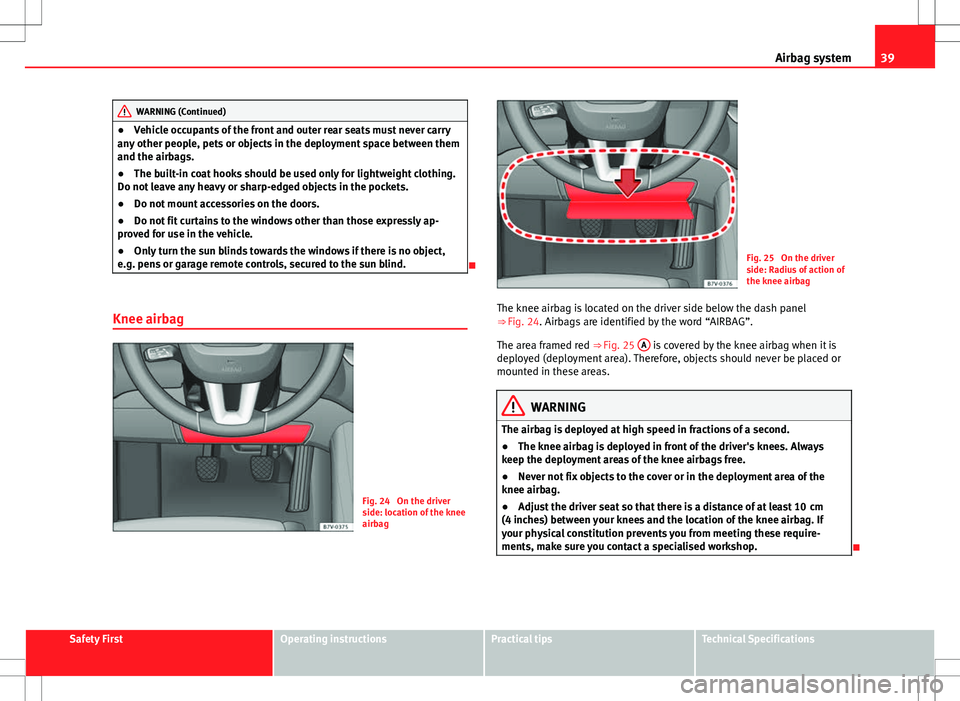
39
Airbag system
WARNING (Continued)
● Vehicle occupants of the front and outer rear seats must never carry
any other people, pets or objects in the deployment space between them
and the airbags.
● The built-in coat hooks should be used only for lightweight clothing.
Do not leave any heavy or sharp-edged objects in the pockets.
● Do not mount accessories on the doors.
● Do not fit curtains to the windows other than those expressly ap-
proved for use in the vehicle.
● Only turn the sun blinds towards the windows if there is no object,
e.g. pens or garage remote controls, secured to the sun blind.
Knee airbag
Fig. 24 On the driver
side: location of the knee
airbag
Fig. 25 On the driver
side: Radius of action of
the knee airbag
The knee airbag is located on the driver side below the dash panel
⇒ Fig. 24. Airbags are identified by the word “AIRBAG”.
The area framed red ⇒ Fig. 25 A
is covered by the knee airbag when it is
deployed (deployment area). Therefore, objects should never be placed or
mounted in these areas.
WARNING
The airbag is deployed at high speed in fractions of a second.
● The knee airbag is deployed in front of the driver's knees. Always
keep the deployment areas of the knee airbags free.
● Never not fix objects to the cover or in the deployment area of the
knee airbag.
● Adjust the driver seat so that there is a distance of at least 10 cm
(4 inches) between your knees and the location of the knee airbag. If
your physical constitution prevents you from meeting these require-
ments, make sure you contact a specialised workshop.
Safety FirstOperating instructionsPractical tipsTechnical Specifications
Page 43 of 387
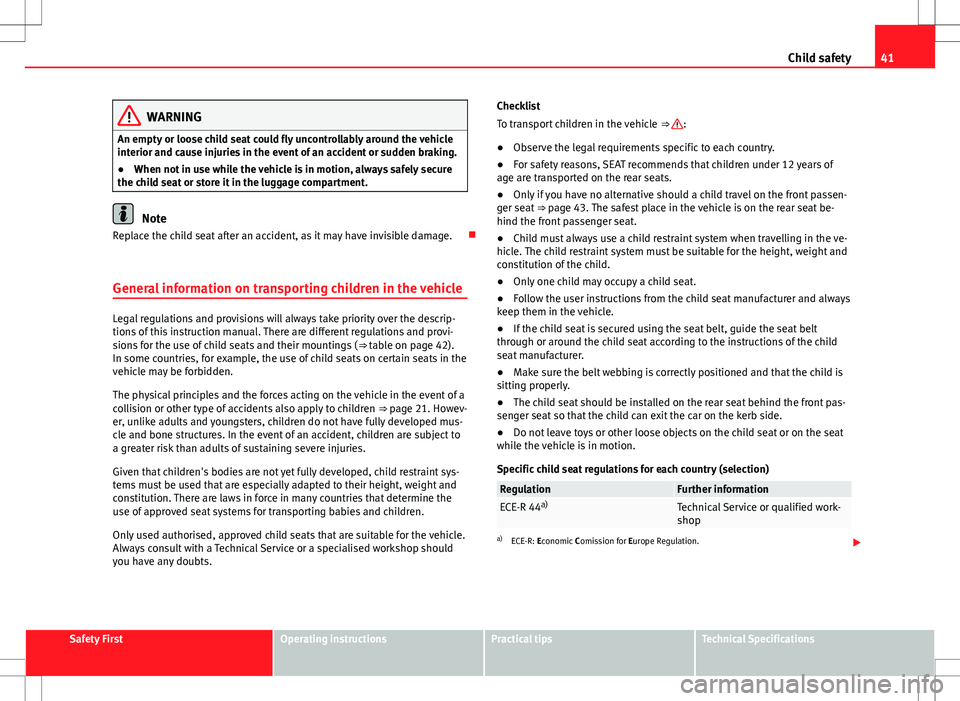
41
Child safety
WARNING
An empty or loose child seat could fly uncontrollably around the vehicle
interior and cause injuries in the event of an accident or sudden braking.
● When not in use while the vehicle is in motion, always safely secure
the child seat or store it in the luggage compartment.
Note
Replace the child seat after an accident, as it may have invisible damage.
General information on transporting children in the vehicle
Legal regulations and provisions will always take priority over the descrip-
tions of this instruction manual. There are different regulations and provi-
sions for the use of child seats and their mountings ( ⇒ table on page 42).
In some countries, for example, the use of child seats on certain seats in the
vehicle may be forbidden.
The physical principles and the forces acting on the vehicle in the event of a
collision or other type of accidents also apply to children ⇒ page 21. Howev-
er, unlike adults and youngsters, children do not have fully developed mus-
cle and bone structures. In the event of an accident, children are subject to
a greater risk than adults of sustaining severe injuries.
Given that children's bodies are not yet fully developed, child restraint sys-
tems must be used that are especially adapted to their height, weight and
constitution. There are laws in force in many countries that determine the
use of approved seat systems for transporting babies and children.
Only used authorised, approved child seats that are suitable for the vehicle.
Always consult with a Technical Service or a specialised workshop should
you have any doubts. Checklist
To transport children in the vehicle
⇒
:
● Observe the legal requirements specific to each country.
● For safety reasons, SEAT recommends that children under 12 years of
age are transported on the rear seats.
● Only if you have no alternative should a child travel on the front passen-
ger seat ⇒ page 43. The safest place in the vehicle is on the rear seat be-
hind the front passenger seat.
● Child must always use a child restraint system when travelling in the ve-
hicle. The child restraint system must be suitable for the height, weight and
constitution of the child.
● Only one child may occupy a child seat.
● Follow the user instructions from the child seat manufacturer and always
keep them in the vehicle.
● If the child seat is secured using the seat belt, guide the seat belt
through or around the child seat according to the instructions of the child
seat manufacturer.
● Make sure the belt webbing is correctly positioned and that the child is
sitting properly.
● The child seat should be installed on the rear seat behind the front pas-
senger seat so that the child can exit the car on the kerb side.
● Do not leave toys or other loose objects on the child seat or on the seat
while the vehicle is in motion.
Specific child seat regulations for each country (selection)
RegulationFurther informationECE-R 44 a)Technical Service or qualified work-
shop
a)
ECE-R: Economic Comission for Europe Regulation.
Safety FirstOperating instructionsPractical tipsTechnical Specifications